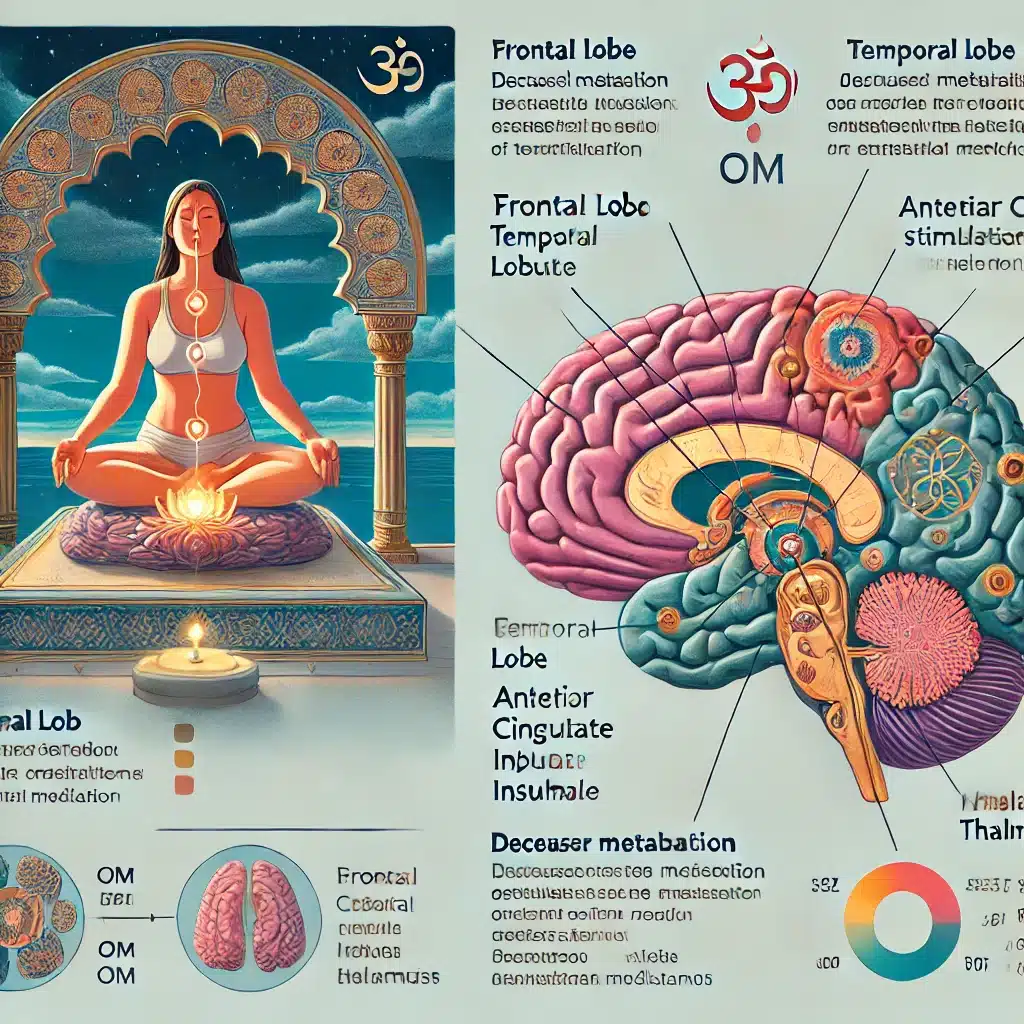Long-term practitioners of Orgasmic Meditation (OM) show distinct patterns of reduced brain metabolism compared to non-meditators, with significant differences in various brain regions involved in cognition, attention, and emotional regulation.
Highlights:
- Reduced Metabolism: OM practitioners exhibit significantly lower metabolic activity in the frontal, temporal, and parietal lobes, as well as the anterior cingulate, insula, and thalamus, compared to non-meditators.
- Sex Differences: Female OM practitioners show notably lower metabolism in the thalamus and insula compared to female controls, while male practitioners show decreased metabolism in the cerebellum, cingulate gyrus, and temporal lobes.
- Affected Brain Networks: The reduced metabolism is observed in several major brain networks, including the Default Mode Network (DMN), Salience Network, and Dorsal Attention Network (DAN).
- Comparison with Other Practices: The unique pattern of cerebral metabolism in OM practitioners suggests that OM affects the brain differently from traditional meditative practices and sexual stimulation alone.
Source: Frontiers in Neuroimaging (2024)
Study Overview: Long-Term Orgasmic Meditation vs. Brain Activation (2024)

The study investigated the long-term effects of Orgasmic Meditation (OM) on brain metabolism, focusing on differences in brain structure and function compared to non-meditators.
Sample
- OM Practitioners: 40 subjects (20 males, 20 females) with over 1 year of regular practice (2–3 times per week).
- Control Group: 19 healthy non-meditators (10 males, 9 females) with no significant history of meditation practice.
Methods
- Imaging Technique: 18F fluorodeoxyglucose (FDG) PET scans.
- Procedure: All subjects received an intravenous injection of FDG. Resting PET scans were performed using a standard imaging protocol. Brain images were processed and analyzed using statistical parametric mapping (SPM12) and compared between OM practitioners and non-meditators.
- Analysis: Voxel-wise two-sample t-tests to determine differences in cerebral glucose metabolism. Correction for multiple comparisons using Gaussian Random Field (GRF) theory.
Limitations
- Sample Size: The relatively small sample size may limit the generalizability of the findings.
- Self-Reporting: Reliance on self-reported meditation experience, which could affect accuracy.
- Comparison Group: Lack of an active control group performing similar sexual stimulation without meditation.
- Sex Bias: The study included only male-female pairs, not accounting for female-female pairs.
- Measurement Specificity: Difficulty in determining the most relevant aspects of meditation practice (frequency, intensity, duration) for the observed effects.
Specific Long-Term Effects of Orgasmic Meditation (OM)

Reduced Metabolism in Key Brain Regions
Frontal, Temporal, Parietal Lobes: These areas showed significantly lower metabolism in OM practitioners compared to non-meditators. The frontal lobes are crucial for higher cognitive functions, including decision-making and social behavior. The temporal lobes play a role in memory and emotional responses, while the parietal lobes are involved in sensory information processing and spatial orientation.
Anterior Cingulate & Insula: Both regions are integral to emotional regulation and interoception (the sense of the internal state of the body). The anterior cingulate is also involved in attention and conflict monitoring.
Thalamus: This region acts as a relay station for sensory and motor signals and plays a role in consciousness and alertness.
Sex-Specific Effects
Females: Showed lower metabolism in the thalamus and insula. These areas are linked to sensory perception, emotional regulation, and sexual arousal.
Males: Demonstrated decreased metabolism in the cerebellum, cingulate gyrus, and temporal lobes. The cerebellum is associated with motor control and coordination, the cingulate gyrus with emotional processing, and the temporal lobes with memory and emotional responses.
Alterations in Major Brain Networks
Default Mode Network (DMN): Includes areas like the angular gyrus and inferior parietal lobule. The DMN is active during rest and involved in self-referential thoughts. Reduced activity in the DMN suggests a more efficient brain state during rest.
Salience Network: Involves the anterior cingulate and insula, which detect and filter important stimuli, aiding in attention and emotional processing.
Dorsal Attention Network (DAN): Includes the middle temporal and inferior frontal regions, responsible for voluntary attention control.
Potential Long-Term Benefits of Orgasmic Meditation (OM)
Enhanced Emotional Regulation
Reduced Activity in the Anterior Cingulate & Insula: May lead to better control over emotions and reduced anxiety levels.
These changes can help in managing stress and improving overall emotional well-being.
Improved Cognitive Efficiency
Lower Metabolism in Frontal and Parietal Lobes: Suggests that the brain might be using energy more efficiently, which could translate to better performance in cognitive tasks that require focused attention and decision-making.
Potential for Therapeutic Use
Implications for Neurological & Psychiatric Conditions: The changes in brain metabolism observed in OM practitioners may offer new approaches for treating conditions like depression, anxiety, and other emotional disorders.
The altered brain activity patterns could help in developing targeted therapies that harness the benefits of meditation practices.
Potential Drawbacks of the Changes
Reduced Sensory & Emotional Responsiveness
Lower Metabolism in the Temporal Lobes & Thalamus: While these changes might suggest improved regulation, they could also lead to a blunted emotional response or decreased sensitivity to sensory inputs.
This could impact the ability to fully experience and react to emotional and sensory stimuli.
Sex-Specific Challenges
Differences Between Males & Females: The distinct effects on brain metabolism between males and females suggest that OM might not be equally beneficial for everyone.
Females might experience greater reductions in sensory perception areas, while males might have more pronounced changes in emotional and social processing regions.
This could lead to differential impacts on daily functioning and emotional health.
Long-Term Neural Adaptations
Potential for Over-Consolidation: The observed reductions in metabolic activity might indicate that the brain has adapted to the repeated practice of OM to the extent that it could affect normal neural plasticity.
This over-consolidation might make it harder to adapt to new experiences or learn new information.
How Orgasmic Meditation (OM) May Change the Brain Over the Long-Term (Possible Mechanisms)

Orgasmic Meditation (OM) induces changes in brain metabolism and function through several key mechanisms involving sensory focus, emotional regulation, and neural plasticity.
Focused Sensory Attention
Mechanism: OM involves intense, sustained focus on clitoral stimulation, which requires the practitioner to concentrate deeply on sensory input.
Effect: This heightened sensory attention can lead to changes in brain regions associated with sensory processing, such as the insula and thalamus. The repetitive nature of this focused attention likely enhances the brain’s ability to filter and process sensory information more efficiently, contributing to reduced metabolic activity in these areas at rest.
Emotional Regulation
Mechanism: The practice of OM emphasizes mindfulness and emotional awareness, fostering a state of calm and relaxation.
Effect: This emotional regulation is reflected in the decreased metabolism observed in the anterior cingulate cortex and insula, areas involved in emotional processing and interoception. Regular practice of OM may help practitioners manage their emotional responses better, leading to a more regulated and less reactive state at rest.
Social & Relational Focus
Mechanism: OM is performed with a partner, promoting feelings of connectedness and intimacy.
Effect: Engaging in a paired practice stimulates brain regions involved in social cognition, such as the fusiform gyrus and angular gyrus. The consistent engagement in this social interaction may enhance the brain’s efficiency in processing social and relational cues, contributing to changes in these regions’ metabolism.
Neuroplasticity & Long-Term Adaptation
Mechanism: Repeated engagement in OM can lead to neuroplastic changes, where the brain adapts structurally and functionally to the practiced behavior.
Effect: Over time, the repeated focus on sensory and emotional aspects of OM may result in structural changes, such as increased gray matter density or altered connectivity in specific brain networks. These adaptations are likely responsible for the observed reductions in metabolic activity, as the brain becomes more efficient in performing the practiced tasks.
Reduction in Default Mode Network (DMN) Activity
Mechanism: OM involves a state of focused attention, which contrasts with the mind-wandering state typically associated with the DMN.
Effect: Regular practice of OM may lead to reduced activity in the DMN during rest, as the brain shifts from a default, self-referential mode to a more focused and present state. This shift is reflected in decreased metabolism in regions such as the precuneus and medial prefrontal cortex, which are key components of the DMN.
Integration of Cognitive & Sensory Processing
Mechanism: OM combines cognitive elements of meditation with intense sensory input, requiring the integration of both cognitive and sensory processing.
Effect: This integration likely enhances the connectivity and efficiency of neural networks involved in these functions, such as the dorsal attention network and salience network. The enhanced integration can lead to more effective cognitive processing and emotional regulation, contributing to the observed changes in brain metabolism.
Conclusion: Orgasmic Meditation & Long-Term Brain Changes
This study provides compelling evidence that long-term practice of Orgasmic Meditation (OM) leads to significant changes in brain metabolism, particularly in regions involved in cognition, emotional regulation, and sensory processing.
These alterations suggest that OM practitioners may experience enhanced emotional control and cognitive efficiency, potentially offering therapeutic benefits for conditions like anxiety and depression.
However, the gender-specific differences and the reduction in sensory responsiveness indicate that the practice might not be equally beneficial for everyone and could have varying impacts on daily functioning.
Overall, while OM shows promise as a unique meditation practice with specific neurophysiological effects, further research is needed to fully understand its long-term implications and optimize its application for mental health improvement.
References
- Study: Neuroimaging evaluation of the long term impact of a novel paired meditation practice on brain function (2024)
- Authors: Andrew B. Newberg et al.







